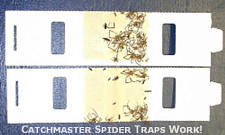 Spider Traps Work!
Spider Traps Work!
Dealing with spiders in your home can be scary; not just the spiders but the dizzying array of products meant to control the spider population. We help you sort it all out.
[Discounts on Catchmaster Spider Traps]
By Scott Sellinger
With so many types of spider control methods out there, how do you choose? We try to make it easy. From Pest Control Companies to Spider Control Sprays to the most effective and Safe Spider Traps, just read on!
After all, we want to keep our family safe. We will wrap up with an overview of spider traps to control spiders without the spending a fortune on professional exterminators or pesticide poisons.
Pest Exterminators?
You could use an Spider Exterminator. Professional exterminators control spiders with poisons and insecticides sprays and will guarantee their work. While on the surface the results meet your desire for spider population control, you need to ask a few questions:
- Is there a monthly pest control contract?
- How safe are the spider pesticides?
- Will pesticide poisons hurt my children or pets?
In some cases, the professional spider control approach can be costly, and the chemical pesticides harsh.
Do it yourself Spider Control Sprays
Of course you can reduce the cost of spider control by finding pesticides in the home improvement or hardware store or online. When choosing this path you will need to be VERY careful, pesticides can be dangerous, but at the same time what you and I can buy are far less potent than the pest control company.
When you do apply the spider killer, be aware of areas where it’s not the best idea to spray pesticides (like food storage areas, cabinets, or office environments). You are solely responsible for damage you may cause, and that means to your pets and family. So think carefully before deciding to go with do-it-yourself pesticides.
Spider Traps – What makes them work best?
The final choice in spider control is also the safest! Spider glue traps are the gold standard safe way to get rid of spiders. These sticky traps are eco-friendly and some are even Green Spider Traps!
In some cases when you point out to a pest control company that you have pets, and children they may actually use the same spider traps that we are describing here! But they will still charge you the same!
Glue based spider traps typically use no poisons and but you should confirm the bait is food based and not poison based.
There are a variety of spider traps on the market, some that cost over $2.95 each and have chemicals that you can’t even find listed. We want to point out some simple facts about spider traps and what makes them effective!
First consider the size of a spider trap. Larger traps do not make better traps! Why? because spider glue traps use glue to trap the spider, the total size of the trap does not matter because after the first step the spider is trapped! This means that the size of the edge of the trap is important.
Second don’t by very expensive spider traps, because spiders don’t wander very far, so 1 spider trap with 3 inches of edge stationed in the living room is not as good as 6 smaller spider traps within 3 inches of edge stationed on the doorways and long walls for the same price!! You end up with 6 times more coverage for the same price!!
Lastly, the bait, while important (always choose a food based attractant like the catchmaster spider traps) is not as critical as the number of traps and where they are placed!
Choosing Spider Traps
There are several spider traps on the market (including Traps Direct, Catchmaster and others).
Among the features to look for in a spider trap consider:
- Trap Surface Margins
The trap entry margin is the space from the edge of the trap to the start of the sticky area.
Ideally, there is no space without glue (also called Zero Margin, edge-to-edge or in some brands ‘ambush edge’ )- Active Trap Field Entrance (ATFe)
How long is the edge an insect would enter (ATFe – Active Trap Field Entrance) and how much of that is Zero Margin Entry. So a 13 ATFe 100% is better than the same trap with 33% Zero Edge which would be rated 13 ATFe 33% - Trap Active Catch Field (TACF)
Some spider traps will also display a TACF rating which is the length in inches of the trap field (ATFe) but instead of a percentage, 50% of the Zero Edge Length is added to the rating.
This makes it easier to compare a single number:
Look for a higher than a 10 TACF
- Active Trap Field Entrance (ATFe)
- Appearance
Is the trap color or marketing obnoxious? Will it stand out or is it attractive enough to not draw attention?
We explore the price vs quality and help you choose the best solution for the price in the article : “Choosing Spider Traps”.